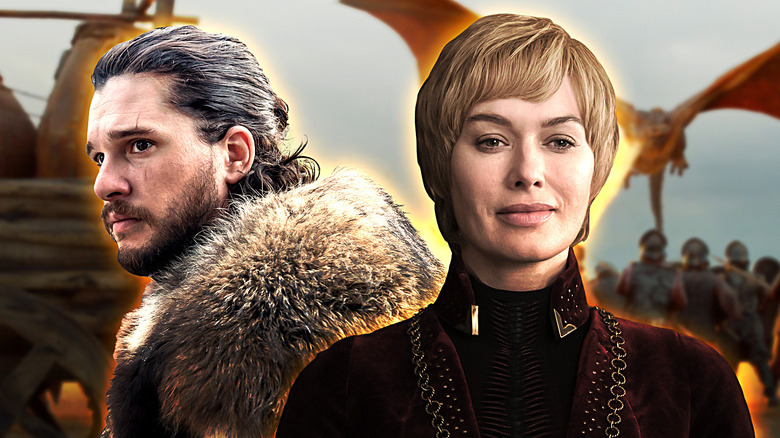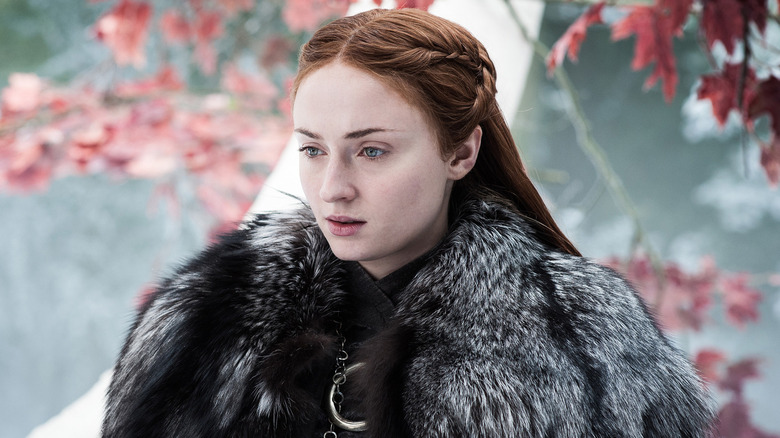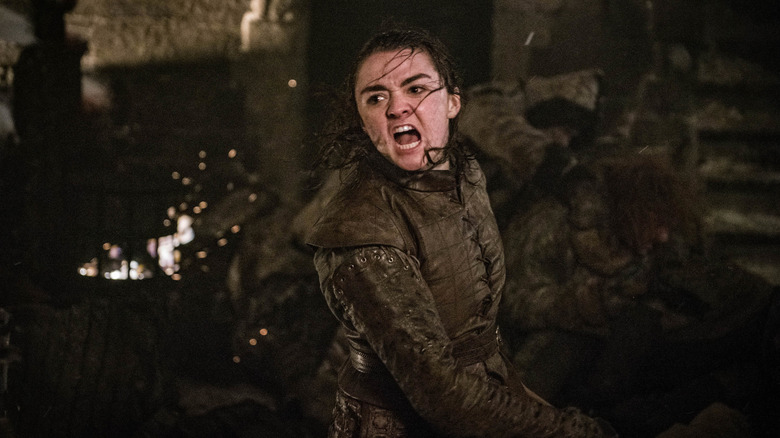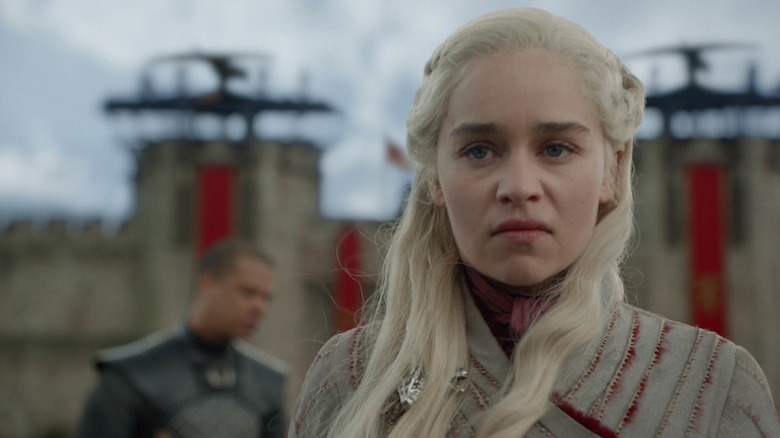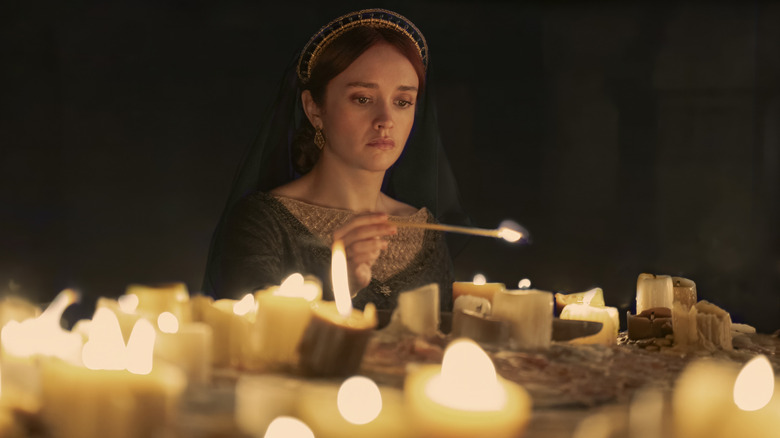Game Of Thrones' Total Death Count Is A Lot Higher Than You Likely Think
During the heyday of "Game of Thrones," which ran on HBO from 2011 to 2019, fans used to joke that newcomers shouldn't get attached to any one character, as they'd just end up dying a gruesome death on-screen. Those fans weren't wrong. The series that made its name by chopping off the head of presumptive protagonist Ned Stark (Sean Bean) at the close of its first season — a major plot twist faithfully adapted from George R.R. Martin's original book series "A Song of Ice and Fire," which served as the show's source material — trafficked in bloody, brutal deaths across its eight seasons. Everyone remembers watching Robb, Catelyn, and Talisa Stark (Richard Madden, Michelle Fairley, and Oona Chaplin) hacked practically to pieces at the infamous Red Wedding in Season 3, Ned's beheading, or the mind-blowing ending (pun intended) of Oberyn Martell's (Pedro Pascal) public duel against Ser Gregor Clegane (Hafþór Júlíus Björnsson). At the end of the day, death was really what "Game of Thrones" was all about.
Still, you might underestimate exactly how many people perish during the acclaimed show's 73-episode run. Luckily, in 2019 — shortly after the show ended not with a bang, but with the bleakest of whimpers — The Washington Post put together a clever interactive infographic about all of the show's deaths, which brought the number to a whopping 6,887 fatalities. So how were they spread out by season, who had the most kills, and how is the show's major spin-off continuing this tradition?
How do the deaths in Game of Thrones shake out when you consider each season?
From vitally important characters to background fighters, a lot of people die throughout "Game of Thrones," whether they're brought down by arrows, swords, magic, the undead, dragonfire, or some other horrific method. So how do they break down across eight seasons? Very unevenly, as it turns out!
According to the interactive post — which, it should be said, features some pretty phenomenal illustrations of the show's cast of characters, including its direwolves and dragons — Season 1 starts off on the lighter side with just 59 deaths, though that does include the momentous beheading of Ned Stark alongside a few other important players. Season 2 ups the ante thanks to the beloved battle episode "Blackwater," killing off a total of 130 players (including Genthin Anthony's Renly Baratheon, the only major character to die in that season). While Season 3 that gets considerably bloodier — thanks in large part to the Red Wedding and Daenerys Targaryen's (Emilia Clarke) quest to overtake the cities of Slaver's Bay — its total death count dips down to 87, and the number grows slightly to 181 in Season 4 thanks to the Purple Wedding that kills Joffrey Baratheon (Jack Gleeson), Oberyn's death, and the murder of Tywin Lannister (Charles Dance).
Season 5 sees 246 deaths — the battle at Hardhome and relentless attacks in Mereen by the Sons of the Harpy see to that — but Season 6 rises to 540 after the Battle of the Bastards between Jon Snow (Kit Harington) and Ramsay Bolton (Iwan Rheon). Season 7 sees 1,096 deaths but only those of a few main characters (Daenerys' dragon Viserion among them) and Season 8, the last one, brings it all home with 4,548 deaths.
Which Game of Thrones character has the most kills?
Outside of two of the show's dragons, Arya Stark (Maisie Williams) has the most kills, and it's not particularly close. In fact, that enormous death number in Season 8, which sees the Battle of Winterfell — pitting the series' remaining human characters against the undead army of the Night King, played in that season by Vladimir Furdik — is due in large part to Arya, who takes down the Night King herself and decimates his entire army by besting him. After Arya slays the Night King with a dagger made of Valyrian steel — one of the only weaknesses of a White Walker — the army crumbles into dust, which, according to the infographic, accounts for a whopping 1,214 kills. In total, Arya has 1,278 kills, thanks to her time as a faceless assassin and her constant desire for revenge (her nemesis, Lena Headey's Cersei Lannister, doesn't even come close to touching Arya with a meager 199 kills throughout the series).
Besides Arya, Daenerys' enormous dragons Drogon and Rhaegal take the number one and number three spots for the highest body counts, which makes sense; unlike Arya, the two massive beasts are capable of wiping out entire armies or fleets with a single fiery breath. Thanks to Daenerys' apparent preference for Drogon, though — as well as the fact that Rhaegal is killed by enemy forces in Season 8 — he takes the top spot with 1,426 kills, most of which take place at King's Landing. So what happened there? Nothing good!
By the end of Game of Thrones, the body count was extraordinarily high
So why do the death counts rise appallingly in the final two seasons? Part of that is, again, thanks to the army of wights and White Walkers, which all vanish at once thanks to Arya's quick dagger work, but it's also because Daenerys succumbs to the (apparently genetic) Targaryen madness after losing two of her three dragons as well as her trusted advisor and friend Missandei (Nathalie Emmanuel), who gets beheaded by Cersei after a Lannister victory. After storming King's Landing and forcing Cersei and her forces to surrender, Daenerys simply... turns Drogon onto the city like a lethal firehose anyway, killing an indeterminate number of innocent civilians as the city burns and collapses under dragonfire.
This controversial move spearheaded by showrunners David Benioff and D.B. Weiss — who reportedly chose to end "Game of Thrones" on the earlier side so they could go make a "Star Wars" movie that ultimately got canned — provided the single biggest instance of fatalities in the series to date. The show wasn't quite finished killing people, either. Just when Daenerys thinks she's finally won the Iron Throne after years of traveling and fighting, Jon Snow, her lover-nephew, shows up in the throne room and gives her a dagger in the gut for her troubles as he realizes he must protect the realm from a woman who just massacred thousands.
All in all, "Game of Thrones" was one of the deadliest shows on television. So how is its first spin-off faring so far?
House of the Dragon is already racking up a decent death count
So far, the first major spin-off for "Game of Thrones" — "House of the Dragon," which also serves as a prequel — is shaping up to be pretty bloody, though it's still in its early days and probably won't match the original's body count any time soon, if at all. The show, which is based on George R.R. Martin's novella "Fire & Blood," begins 172 years before Daenerys' birth and focuses on her ancestors as King Viserys I Targaryen (Paddy Considine) must consider who will take the throne upon his death. In one corner, we've got his eldest child Rhaenyra Targaryen, played as a teenager by Milly Alcock and as an adult by Emma D'Arcy, who has the utter misfortune of being a girl; in the other, we have the children Viserys has with his second wife, Rhaenyra's childhood confidante Alicent Hightower (Emily Carey and Olivia Cooke).
The new show has, certainly, seen its share of bloodshed — characters murder each other with relative impunity (this is Westeros, after all). After a small time jump, Rhaenyra and Alicent's children end up in an altercation that sees one of them lose an eye; six years after that, the injured party Aemond Targaryen (Ewan Mitchell), Alicent's son, seeks revenge on his nephew Lucerys Velaryon (Elliott Grihault), Rhaenyra's son, over the fight. Unfortunately for Lucerys and his dragon Arrax, this means that the duo faces off against Aemond and his large steed Vhagar ... and lose. In the show's sophomore season, proceedings kick off with a particularly nasty murder, and considering that the series is about a civil war within one family, there's more bloodshed to come.
"Game of Thrones" and "House of the Dragon" are both streaming on Max now.
